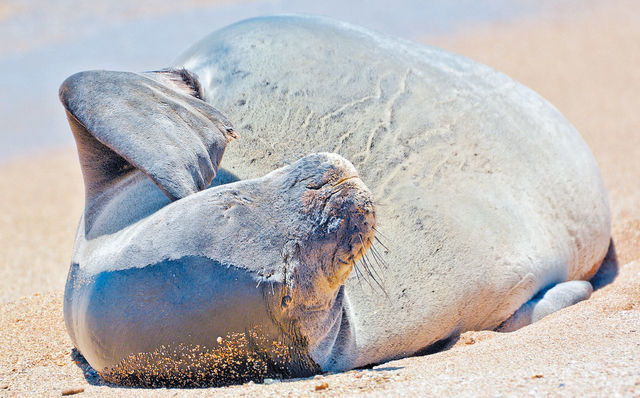LIHUE — Federal regulators want to more than double the small population of endangered Hawaiian monk seals in the state’s main islands. The National Oceanic and Atmospheric Administration’s National Marine Fisheries Service on Tuesday released a draft management plan for
LIHUE — Federal regulators want to more than double the small population of endangered Hawaiian monk seals in the state’s main islands.
The National Oceanic and Atmospheric Administration’s National Marine Fisheries Service on Tuesday released a draft management plan for the endangered species, of which about 200 live in the main Hawaiian Islands.
Among the goals of the plan is to create a stable or growing population of more than 500 seals in the main Hawaiian Islands. There are about 1,100 Hawaiian monk seals total, with most of them living in the uninhabited Northwestern Hawaiian Islands.
There are 45 to 50 monk seals known to regularly visit Kauai.
Rachel Sprague, Hawaiian monk seal recovery coordinator for NOAA Fisheries, said that while the plan sets a vision for a growing seal population, its primary intention is to provide management practices geared at creating an environment where the seals we have now can better coexist with humans.
“I don’t wake up in the morning and think, ‘How are we going to get closer to 500 seals?’” said Sprague, who is the lead author of the draft management plan. “Those numbers are not what a recovery program usually spends any time thinking about. What we’re thinking about is how do we build a framework to help us manage the seals that we have here now, while keeping in mind this vision of what we eventually want the population to grow to be.”
The 500 number is not arbitrary. The Hawaiian monk seal will be considered to be in recovery when there are 500 seals in the main Hawaiian Islands and 2,900 seals in the Northwestern Hawaiian Islands.
“People are not ready for 500 seals tomorrow,” Sprague said. “It’s going to be more than 50 years to get to that number, if we ever do.”
Other goals of the plan include identifying sick or injured seals, education and outreach programs and better communication with fishermen.
The plan was built collaboratively over the course of several years with input from recreational and commercial fishermen, recreational ocean users, tour companies, Hawaiian cultural practitioners, educators, nonprofits, government agencies, local politicians and neighborhood leaders.
Officials have opened the draft to a 30-day public review and comment period.
Monk seals are threatened by disease from humans and other animals, fish hooks and nets as well as intentional killings.
Last December, a female monk seal pup was found bludgeoned to death along a rocky beach in Anahola. Another 2-week old female seal was found dead the previous July with deep puncture wounds to the neck as a result of a dog attack. In 2009, a man on Kauai was charged with shooting a pregnant female seal twice with a gun.
Killings like these are sometimes fueled by misinformation that Hawaiian monk seals are not Hawaiian because they were rarely seen on the main Hawaiian Islands until their numbers started stabilizing in the last couple of decades.
Tim Robinson, projects coordinator for Kauai Monk Seal Watch Program, said NOAA’s draft management plan is a good one.
“It’s necessary to foster their growth in the main islands because their habitat in the Northwest Islands is probably not going to exist in 50 to 100 years,” Robinson said. “Many of those little atolls where there are significant monk seal populations could disappear with significant ocean level rises. They are only a few feet above sea level. If that’s the case, long-term the main Hawaiian Islands are really their only environment left.”
The focus of Kauai Monk Seal Watch Program is its education outreach work with local students and tourists. The group also often finds itself fielding monk seal sighting reports.
Sprague agreed that encouraging the seal’s natural growth and stabilization in the waters surrounding Kauai, Niihau, Oahu and Molokai, the main islands where the species is most prominent, could be key to its future survival.
“The main Hawaiian Islands may be the best hope for saving the species,” she said, “so if we want that to happen we need to figure out how that can happen while doing right by the people and doing right by the seals.”
••• The Associated Press contributed to this report.


